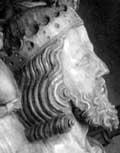| The fourth son of King Edward I and Eleanor of Castile, Edward became heir apparent when his eldest surviving brother, Alphonso of Chester, died on 19 Aug 1284. Edward's mother died when he was six and his father's continued absences in wars placed the young prince under the influence of extravagant courtier, Piers (Peter) Gaveston, a Gascon knight. Edward succeeded to the throne upon his father's death in 1307 and immediately created Gaveston the earl of Cornwall. Gaveston served as guardian of the realm (appointed 26 Dec 1307) during the king's trip to France until 7 Feb 1308. Twenty-eight barons, known as the Lords Ordainer, irritated by the king's appointments and favorites, drafted the Ordinances demanding the banishment of Gaveston and the limitation of the royal powers. Edward conceded to the Ordinances (October 1311), but in early 1312 Gaveston returned by the king's command. When Edward returned to Gaveston his castles and appointed to new offices, the barons had the favorite arrested and executed (19 Jun 1312). Responding to the revolt of Robert the Bruce, Edward II led an army to Scotland, where it was decisively defeated by Bruce at Bannockburn (24 Jun 1314). The Lords Ordainer led by Thomas of Lancaster virtually governed the country and the king found himself under the influence of Hugh le Despenser and his son and namesake. In 1321 Edward confronted the most powerful barons on a battlefield, beheaded Thomas of Lancaster (22 Mar 1322) and revoked the Ordinances. The Despensers attached new lands to their dominions and caused the enmity of Edward's queen, Isabella, sister of the French king Charles IV. While on a mission to France, Isabella conspired with Roger Mortimer baron of Wigmore and refused to return until the Despensers were removed from court. In September 1326, Isabella and Mortimer led an invasion against Edward II, who escaped to Wales. On the presumption that the king "disappeared", a council of barons at Bristol declared the king's son, Prince Edward (future Edward III), guardian of the realm (26 Oct 1326). The Earl of Lancaster captured Edward II at Neath Abbey (16 Nov 1326) and detained him at Kenilworth. Edward II refused to attend the Parliament summoned in his name at Westminster, thus making it illegitimate. On 13 Jan 1327 this assembly, nevertheless calling itself Parliament in official records, agreed on the deposition of the King. A deputation of bishops, barons, and judges, sent to Kenilworth, formally renounced homage to Edward II and accepted the king's forced abdication on 20 Jan 1327. Imprisoned at Berkeley Castle, Edward died in September 1327, probably by violence. [2; 3] |

